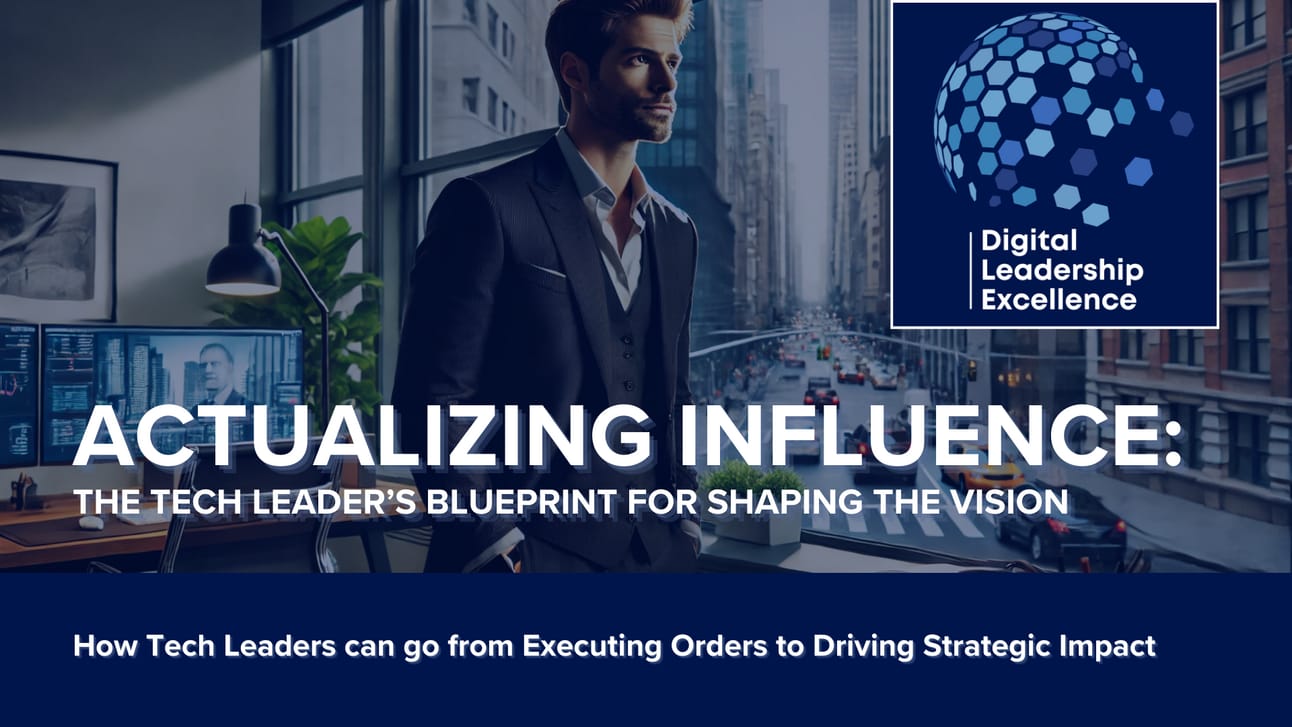Greetings, and welcome to Digital Leadership Excellence—your trusted weekly guide to excelling in tech leadership, delivering results, and thriving with clarity and purpose. In every issue, we provide insights into winning strategies, growth tactics, and practical solutions, designed to support both current and aspiring technology leaders navigating the ever-evolving digital world.
1.0 Introduction
Last month, I sat across from Tom (not his real name), a VP of Technology at a multi-billion dollar company. His team had just delivered a massive digital transformation project - on time, under budget.
Yet he was frustrated.
"I'm tired of being the guy who just executes everyone else's vision. I want to SHAPE the vision."

Sound familiar?
Here's the reality: Technical excellence alone won't transform you from service provider to strategic partner. I learned this lesson the hard way during my 30+ years leading technology teams at both giant companies and startups.
Today, I'm sharing the EXACT blueprint that's helped my clients make this transformation. (Including how two of them landed CIO roles in the past year.)
Let's dive in...
2.0 The Harsh Truth About Strategic Influence
Most technology leaders think their path to strategic influence looks like this:
Deliver perfect projects → Get noticed → Get invited to strategic discussions
WRONG.
It’s not bad - it’s just not how the world works.
Here's why this approach fails:
Perfect execution is expected, not exceptional
Technical expertise doesn't automatically translate to strategic value
Waiting to be noticed puts you in a reactive position

3.0 The Transformation Blueprint
The shift from service provider to strategic partner requires three fundamental changes:
3.1 MINDSET SHIFT: From Problem Solver to Opportunity Creator
STOP thinking: "How can I solve this problem?"
START thinking: "What opportunities can we create?"
Real Example: One of my clients was asked to reduce cloud costs by 20%. Instead of just optimizing spend, he presented three scenarios:
Option A: 20% cost reduction
Option B: 10% reduction + new revenue-generating capabilities
Option C: Current spend + market expansion opportunities
Guess what? The leadership team chose Option C because he shifted the conversation from cost to value creation.
3.2 COMMUNICATION SHIFT: From Technical to Strategic
Most technology leaders make this critical mistake: They lead with HOW instead of WHY.
Compare these two approaches:
WEAK: "We need to upgrade our infrastructure to support higher transaction volumes."
STRONG: "Our current technology limits us to 10% market share. This initiative will allow us to capture 30% of the market within 18 months."
See the difference? Same project, completely different perception.

3.3 RELATIONSHIP SHIFT: From Reactive to Proactive
Here's the framework I share with my clients for transforming key relationships:
Phase 1: Intelligence Gathering
Study your business leaders' public statements
Track their KPIs and challenges
Understand their strategic priorities
Phase 2: Value Seeding
Share relevant market insights
Connect technology trends to business opportunities
Test ideas
Introduce innovative solutions before they're asked for
Phase 3: Strategic Positioning
Frame technology decisions in business terms
Present options with clear business impacts
Lead with insights, not updates
4.0 Real World Impact
Let me share how this blueprint transformed one leader's influence in less than 6 months:
Before:
Invited to 20% of strategic planning sessions
Viewed as "technical expert"
Projects evaluated on cost and timeline
After:
Consulted on 80% of strategic decisions
Recognized as "business advisor"
Projects evaluated on business impact
Promoted to CIO with significant compensation increase

5.0 The Practical Playbook
Now, let's break down the EXACT steps you can take to transform your influence starting Monday morning.
5.1 Reframe Every Conversation
Here are the power questions that my most successful clients use to shift from tactical to strategic discussions:
→ Instead of: "What are the requirements?" Ask: "What business outcomes will define success?"
→ Instead of: "When do you need this?" Ask: "How would accelerating or delaying this impact our market position?"
→ Instead of: "Who needs to approve this?" Ask: "Who else might benefit from these capabilities?"
These questions don't just get better answers - they change how people see you as a leader.

5.2 Master The Strategic Narrative
Here's the framework that transformed one client's executive presentations:
Before: "We need $2M for a cloud migration project..."
After: "I've identified three opportunities to accelerate our market growth:
Option A enables 15% customer acquisition increase
Option B reduces time-to-market by 40%
Option C opens new revenue streams worth $10M annually
The technology investment to capture these opportunities is $2M..."
See what happened? Same request, completely different conversation.
5.3 Build Your Influence Ecosystem
Most technology leaders focus on their direct stakeholders. BIG MISTAKE.
Here's the influence map my successful clients use:
Primary Circle:
Direct business partners
Key decision makers
Budget holders
Secondary Circle:
Emerging leaders
Cross-functional peers
Industry contacts
Tertiary Circle:
Market analysts
Technology vendors
Industry thought leaders
Spend 20% of your time nurturing relationships in each circle. This creates a network that amplifies your strategic influence.
5.4 Demonstrate Strategic Foresight
Want to be seen as strategic? Start sharing insights about:
Emerging technologies that could disrupt your industry
Competitor moves and their implications
Market trends that create new opportunities
One client created a monthly newsletter for his executive team (Let’s call it Technology Horizons). Within 90 days, they were proactively seeking his input on strategic decisions.

5.5 Execute The Transformation
Week 1: Mindset Reset
Audit your calendar - how much time do you spend on strategic vs. tactical activities?
Identify three business opportunities you can enable through technology
Prepare strategic narratives for your current projects
Week 2: Communication Evolution
Reframe all project updates using the strategic framework
Schedule informal discussions with business leaders about their long-term vision
Start sharing relevant market insights
Week 3: Relationship Building
Map your influence ecosystem
Identify gaps in your network
Create your strategic relationship action plan
Week 4: Value Creation
Present one strategic opportunity (not requested by others)
Connect with leaders in your secondary and tertiary circles
Document the business impact of your technology initiatives
6.0 Final Thoughts
The transformation from service provider to strategic partner isn't about learning new technical skills. It's about showing up differently as a leader.
Remember Tom from the beginning of this newsletter? Less than 6 months after implementing this blueprint, he was promoted to CIO. But more importantly, he's now shaping his company's future, not just executing someone else's vision.
Your technical expertise got you where you are. But your leadership skills will determine where you go next.
Ready to make this transformation? Drop a comment below with your biggest insight from this blueprint. I read and respond to every comment.


